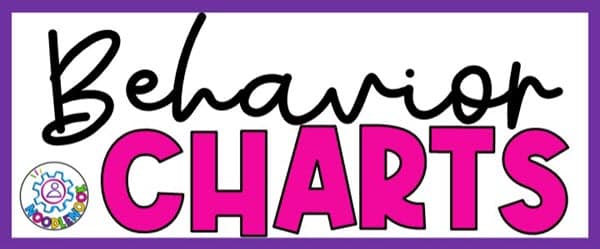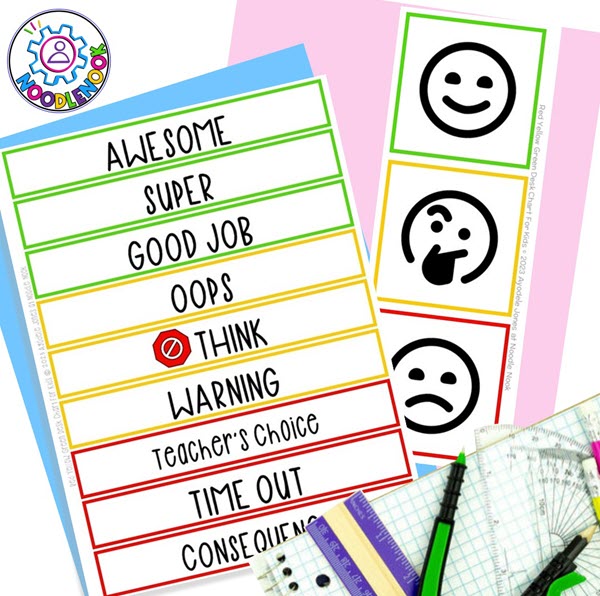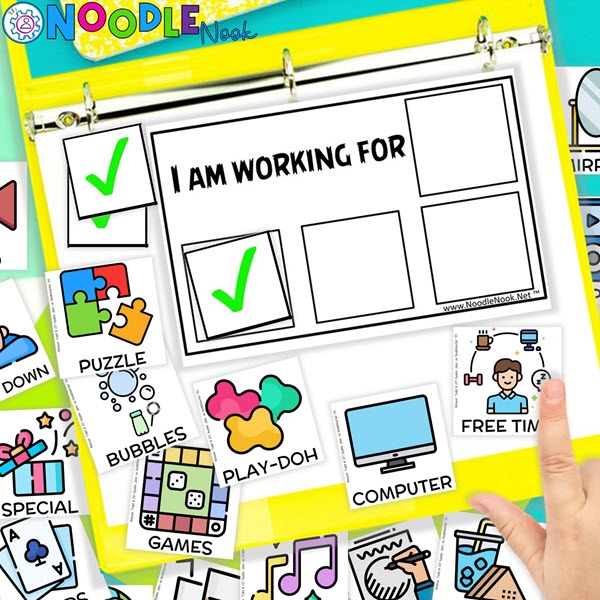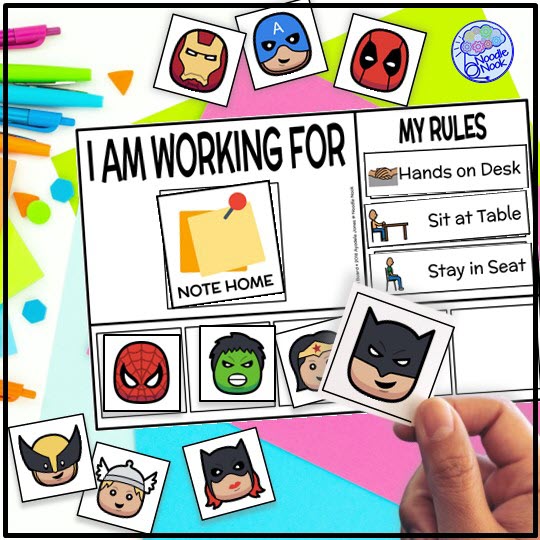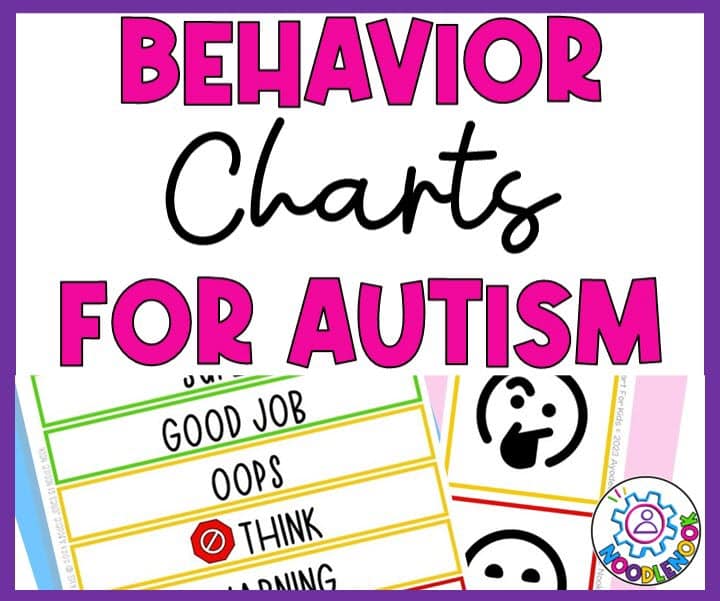As special education teachers, one of the biggest challenges we face is managing behavior in the classroom. These days it feels like every student in our classrooms needs behavior support. But, our students on the autism spectrum consistently need behavior visuals and supports. They seem to consistently struggle with emotional regulation, self-control, and following instructions. Over the years, I’ve tried many different behavior management strategies, but the one that consistently gets results is using behavior charts. In my personal experience, token boards are the best, but we will talk more about token systems later. In this post, we’re going to cover the types of behavior charts, why you need them, and how to implement them effectively.
What is a Behavior Chart?
A behavior chart, also called a reinforcement chart or token board, is a visual tool that allows students to earn rewards for demonstrating positive behaviors. They work on the basic principle of positive reinforcement. When a child engages in a desired behavior that you want to see more of, they receive an immediate reward. This increases the likelihood they’ll repeat that behavior in the future. For kids with autism, behavior charts can be highly motivating because they provide clear expectations and instant feedback on their progress.
How do Behavior Charts Work?
When I first started using a visual behavior reward chart, specifically a token board, I was skeptical. Would my students really buy into earning fake chips or stars to place on a chart? To my surprise, it was an instant hit in my classroom and a powerful way to improve behavior.
Being able to visibly track their accomplishments and work towards a reward they chose really tapped into their engagement and motivation. Suddenly, following directions and staying focused became much more attainable when a prize was looming on the horizon.
Types of Behavior Charts (and When to Use Them)
There are a lot of different charts you can use with students to address negative behaviors. Most of these are connected to long and short-term rewards. The type of tool that you choose will depend on the needs of your students. Here are some common types of behavior charts teachers use with kids of different ages and abilities:
- Smiley Face Charts. Perfect for preschool and kindergarten, these feature different-sized smiley faces corresponding to levels of positive behavior.
- Red-Yellow-Green Chart. Here, kids move their clothespins or photos up or down in response to their behavior as they meet set expectations. This is a great way to manage an entire class using a behavior chart. You can also use this system individually with a color card on a student’s desk.
- Token Boards or Economy Charts. Popular for grades K-5, students earn fake money, stars, or tickets to “purchase” rewards. Visualizing progress inspires good manners and kindness in the classroom.
- Point Sheets. More advanced students track behavior goals or positive choices on a daily or weekly scoring sheet. Reaching a target number allows an outing to the treasure box.
- Group Contingency Charts. The whole class earns rewards together by demonstrating good listening, following directions, and encouraging peers. Teamwork and expectations are clearly posted.
- Communication or Social Skills Cards. For nonverbal children, pictures represent following 1-step prompts, waiting patiently, or asking a friend to play. Independence blossoms when these skills are reinforced.
- Calendars or Wall Posters. Visual schedules promote life skills like brushing teeth, chores, or safety rules. Crossing off finished tasks fosters independence and responsibility.
From color charts to token boards, the most important part of behavior charts for autism is the conceptual connections between the system and the behavior. If you are working with neurotypical children, then this can be easier to establish. With students who have a developmental delay, you may have to choose a board with a more concrete connection.
Why are Behavior Charts Effective?
Visual supports provide predictability, concrete expectations, and immediate feedback – all of which help students off and on the spectrum understand what is being asked of them and whether they are being successful. Rather than relying solely on verbal directions that may not fully register, behavior charts give a visual roadmap for appropriate conduct.
Plus, when reinforcement is linked to specific target behaviors through tools like star charts or token boards, it motivates all kids to engage in positive actions that lead to rewards. The instant gratification of seeing progress on their chart lights up the same reward pathways in their brains reinforced through tangible prizes.
With regular use of a visual behavior system, you’ll be amazed at the communication and behavioral growth that occurs. Self-regulation improves, social skills expand, and learning stays the top priority in your inclusive classroom. So don’t hesitate to start implementing behavior charts today to energize positive change!
Steps to Setting Up Behavior Charts for Autism
- Identify Target Behaviors. It’s best to focus on two to three social or emotional skills that may present challenges, such as making eye contact, sharing toys, or accepting the word “no.”
- Choose a Behavior Chart. Opt for a visual format like a token board, star chart, or calendar that incorporates pictures, photos, or symbols in addition to words since these appeal most to autistic children. Test the student’s comprehension of the chart’s meaning to ensure they understand how it works before implementing it.
- Decide on a Reward and Reinforcement Schedule. Ask the students what age-appropriate prizes they would enjoy working towards, such as extra recess, computer time, or a small toy. Then set an achievable ratio for how many stars, points, or tokens they must earn to trade for a reward, like five to ten.
- Preview the Charts with Students. Model and roleplay how to use the chart, providing hand-over-hand assistance if needed. Point to sample rewards or targets while describing the expected behaviors so the purpose and function are crystal clear from the start.
- Provide Explicit Instruction. Teach the reward system step-by-step using modeling, roleplaying, and social stories if applicable. Demonstrate examples and non-examples of behaviors that do or do not correspond to rewards vs. reminders.
- Implement It Consistently. Integrate its use into the student’s daily school schedule and implement it across instructional environments whenever possible. Fade prompts gradually and be sure to immediately offer praise and rewards when the on-chart behaviors are displayed.
- Deliver on Rewards Paired with Positive Praise. follow through by allowing the student to choose a prize from the reward bank once milestone criteria are met. Couple any prizes with positive praise that acknowledges their hard work and character development.
- BONUS: Take Data to Determine Efficacy. Taking data on problem behaviors and skills before and after will also help determine how well the charts are working and identify any adjustments that may be needed.
Keys to Behavior Charts for Autism Success
There are a few keys to setting up an effective behavior chart or token board system:
- Choose age-appropriate rewards. For elementary kids, things like extra recess, snack time, or computer minutes tend to work well. Make sure to rotate the options so it stays interesting.
- Start with clear, simple targets. Focus on one or two critical behaviors at first, like raising their hand quietly or transitioning calmly. Break large tasks into small steps they can master. When you take on all the things, it’s harder to implement.
- Use visual cues like smiley faces or star sticker charts. When you choose tokens or stickers, keep student preferences in mind. Just using a character a student loves can increase buy-in and efficacy. While verbal students can tell you what they want as a reward, nonverbal kids may benefit from a choice board to select rewards independently.
- Provide immediate feedback. The closer in time you can deliver the token, the stronger the association between the behavior and reinforcement. Praise what they did right as you place the token, sticker, or reward.
- Set a clear earn-to-spend ratio. I’ve found 5-10 tokens or stars per reward works well, depending on the student’s abilities. Don’t make the goal so high it’s discouraging or so low there’s no sense of accomplishment.
Are Behavior Charts ONLY for Students with Autism?
One defining characteristic of autism is difficulty with executive functioning skills like flexibility, organization, time management, and self-control. But we have LOTS of students who struggle with these things. This means behavior boards and charts work for ANY student who may struggle to initiate tasks, shift gears easily, or moderate their emotions when faced with challenges or changes in routine.
That’s why it’s a good idea to have a set of token boards readily available in the classroom. They support all students to be more successful and improve. That includes older children, younger children, children with special needs, and neurotypical kids. Basically, if you’re dealing with problematic behaviors (or just want to improve good behavior on a more regular basis), then you need a set of your own charts in your classroom.
RECAP: Behavior Chards for Autism
Once your behavior chart system is in place, you’ll likely see a dramatic shift in those challenging behaviors. Students may not want to please their teacher, but they will work for rewards! Behavior charts and token boards channel that motivation in more positive directions. Of course, consistency is key – stick with it every day and be sure to follow through when rewards are earned.
If you’re ready to start using behavior charts for autism students in your classroom, I suggest token boards. Not sure where to find printable versions? Check out the NoodleNook Teachers Pay Teachers store. Within one printable resource, you have dozens of options tailored for different ages and abilities, from smiley face charts to rule boards. You can snag their au-some Token Boards featuring highly desired visual here. No designing is needed – just print and laminate. It’s a quick and affordable way to get your positive reinforcement system up and running today.
FAQ on Implementing Behavior Charts
How do I get student buy-in for the behavior chart system?
Involve kids in designing and choosing rewards. Polls help, as does modeling enthusiasm as you give feedback. Linking targets to what’s valued like recess keeps them motivated. Brief previews extend the fun of anticipation. If you want some rewards that don’t cost anything, check out this post here: https://www.noodlenook.net/classroom-reward-ideas/
What if a student isn’t responding to the chart?
Re-evaluate targets and rewards to ensure they’re meaningful. Sometimes social stories explaining the “why” help. Extra support like visual timers keep tasks doable. Most importantly, catch positives and avoid power struggles by redirecting respectfully.
How do I balance individual versus group charts?
Rotate based on student need and lesson context. Independent charts personalize goals while group contingencies foster teamwork. Try both – kids often model peers’ success. Flexibility is key as student strengths and challenges vary daily.
Want your copy of this simple behavior chart visual?
It’s a FREE bonus when you snag your behavior bundle. Get yours today!
Can behavior charts be used alongside other strategies?
Absolutely! They complement social narratives, first-then boards, checklists and more. Layer reinforcement judiciously across systems for maximum effect without overwhelming students. The goal is building independence through a variety of supports. If you want a set of behavior tools that can help you in the classroom, check out the Behavior Toolkit from NoodleNook.
What if problem behaviors continue or get worse?
Consult your behavior specialist for an FBA evaluating triggers. Rule out medical issues too. Simplify the chart, ramp up praise 4-to-1 over redirects, and maintain routines calmly. Focus on relationships first – behavior teaching comes next. You’ve got this!
Where can I find the best behavior charts for autism?
The most popular token board set available on a shared marketplace is this one from NoodleNook. You can grab yours on TPT and get started with behavior charts in your classroom today. With a variety of board types and reward visuals already set to go, you can be up and running tomorrow. Get yours today. Here is the link: https://www.noodlenook.net/wiya

